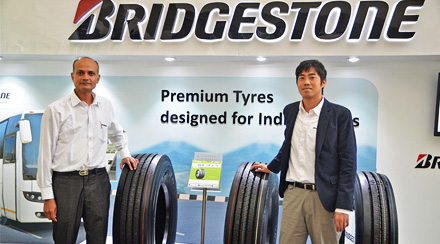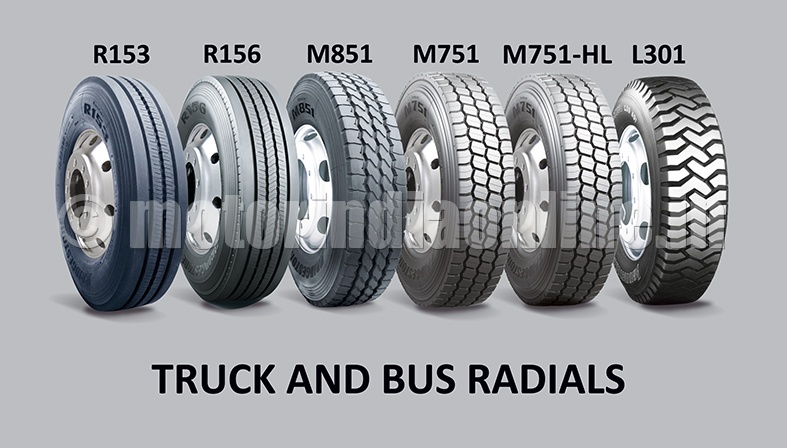Bridgestone, the global tyre industry market leader, had displayed its range of bus radials for the first time in an event in India earlier this year at ASRTU’s International Conference and Exhibition on Public Transport Innovation (ICEPTI 2015). While the Japanese major had lined up three of its bus radials, all eyes were on its new Ecopia model which is slated for launch from next year. The Ecopia range, which has its name derived from a blend of ecology and utopia (ecological heaven), delivers better rolling resistance without compromising on wet grip and wear life when compared to conventional tyres.

Bridgestone has already introduced Ecopia range for the Indian passenger car & SUV market, Ecopia tyres which would cover a much wider range of sizes along with trucks and buses segments – in the near future.
Bridgestone entered the Indian market in 1996 with tyres for the passenger car segment in which it has a strong position today. The company currently has a daily capacity of 15,000 units and 10,000 units at its Indore and Pune facilities respectively for passenger car tyres. The company commenced Truck & Bus Radial (TBR) production in October 2013 with around 1,000 units being rolled out every day from the Pune plant, though the company is expanding the capacity on a monthly basis driven by market demand.
In buses, it is a common practice to use all-position tyres which can be fitted on any of the axles of the vehicle, while axle specific tyres make a major difference in case of bad road conditions. While bias tyres are still quite common in the Indian bus market, OEMs like Volvo have almost completely switched over to tubeless radials that deliver excellent performance and good returns for customers.
Radial effect
Says Mr. S.S. Gusain, SR DGM – Training Centre, Bridgestone India Private Ltd.: “If the roads are excellent, there is a clear difference in performance between radials and bias tyres with radials giving up to 10 per cent better fuel efficiency and 50-100 per cent better wear life than bias tyres. The customer gets these benefits by paying just close to 20 per cent more upfront which results in significant savings overall.”
While fuel efficiency and tyre life are important parameters from a customer’s perspective, radials score over bias in the all-important aspect of safety as well. “The braking distance of radials is at least 10 per cent shorter than bias tyres while their superior cornering force leads to faster and more stable turns as well. Tubeless radials have a 22.5 inch diameter which results in better air flow which in turn leads to reduction in heat and thus significantly reducing brake drum heat related tyre damage”, adds Mr. Gusain.
Though the share of radials in the Indian truck and bus market is not so high, the adoption of radials is growing at a rapid pace, primarily driven by some of the forward-looking fleet customers in the country. Bridgestone, though relatively new in the TBR segment in India, is confident of playing a catalytic role in helping transporters understand the total operating cost benefits of radials.
“In the TBR world, we feel customers in India do not buy a tyre because of the brand; they buy based on performance, price, cost per km and other factors. While there are many customers in India who understand the operating economics very well, there are also many others who do not know it well. We would like to give them proper information and educate them to improve their operations in the long run. We believe that when it comes to tyre life, technology and fuel efficiency, we are better than competitors and while our main aim is to satisfy our customers, we will remain completely transparent and fair in the market”, says Mr. Junya Mochizuki, Manager – TBR Marketing, Bridgestone India Private Ltd.
Customer first
Bridgestone currently has around 30 Bridgestone Fleet Points (BFP) spread across the country, including Fleet Point Mobile for providing service support at customer locations. Apart from tyre sales, the company offers a complete range of tyre repair and maintenance solutions through its BFPs to ensure its customers’ uptime is maintained.
Explains Mr. Gusain: “We develop our products based on Indian specifications because if we have to sell in the Indian market we have to make products suitable for India. Before the launch of any product, we run field tests with some of our fleet customers in addition to the regular lab tests. If we are not satisfied with the field test results, we rework on the product and ensure it is a perfect fit for customers before launching it in the market. Our recent products such as the M851 are made only for India and are not available in any other global market. There are common requirements such as fuel efficiency, wear life, cost, etc., among markets but the order of the parameters in terms of customer priority may vary in different markets, which is why we develop our products based on extensive feedback from our customers.”
While Bridgestone is the preferred tyre brand for many transporters and fleet customers in the country, the company supplies directly to some truck and bus OEMs as well. The global powerhouse is aggressively working on increasing its Indian market penetration by reaching out to other OEMs and fleet customers and also plans to expand the product range in a big way.
“We are focusing on bringing in many more sizes for our existing tyre patterns and will also be launching new patterns which are currently under testing. We are new in the TBR segment in India but we want to grow in this space and eventually become number one in the long run”, concludes Mr. Mochizuki.
